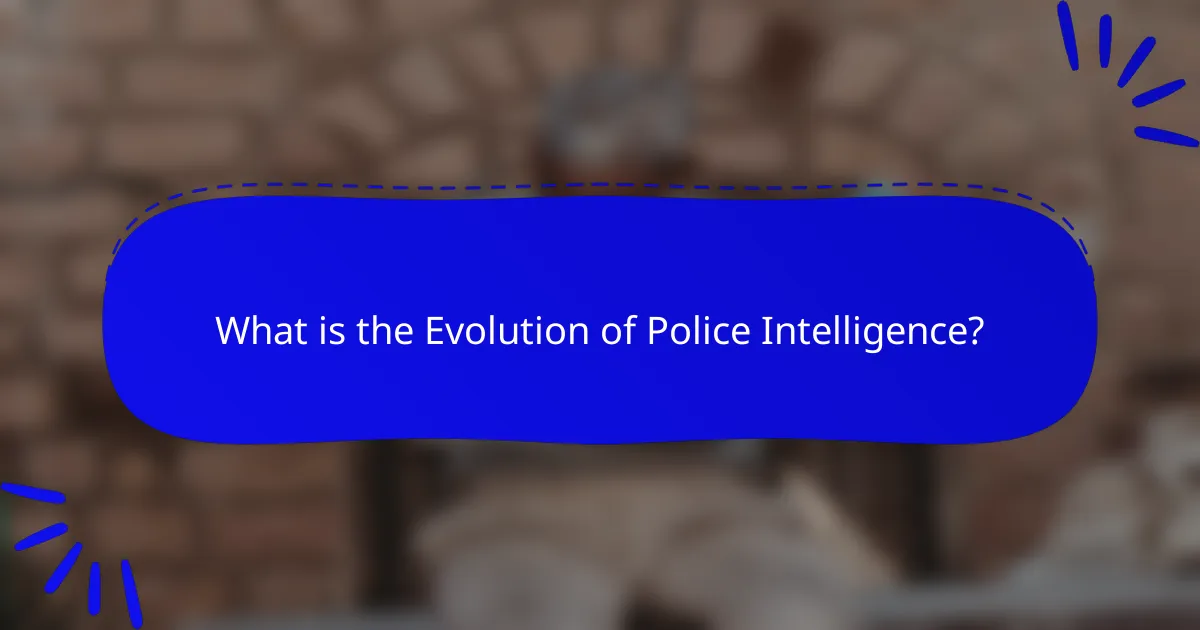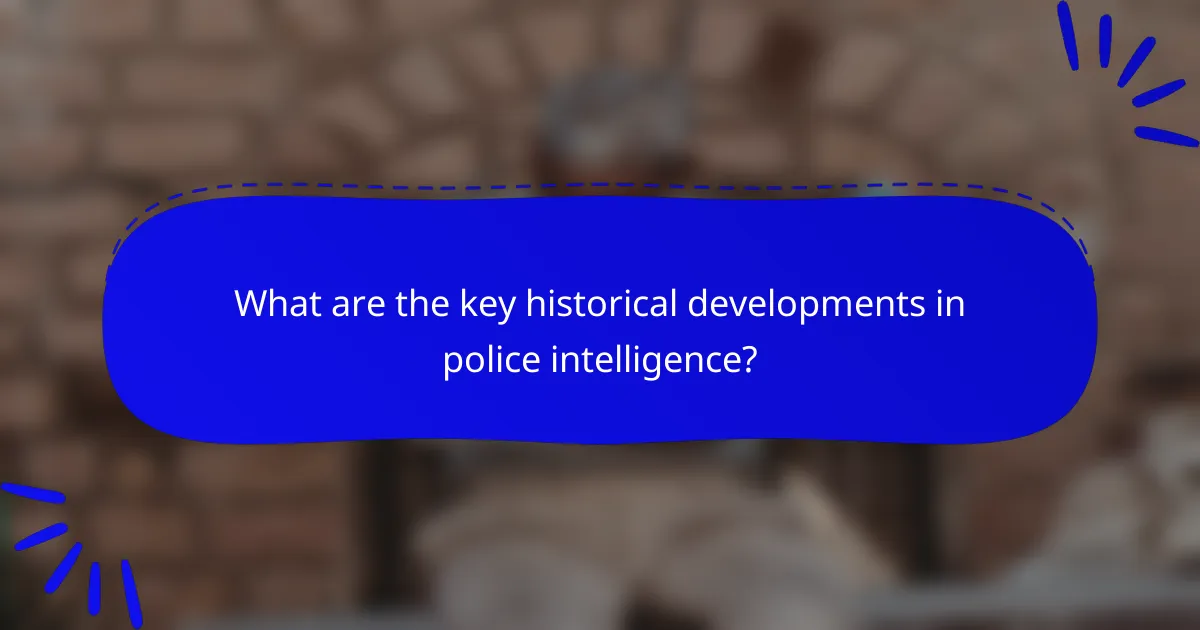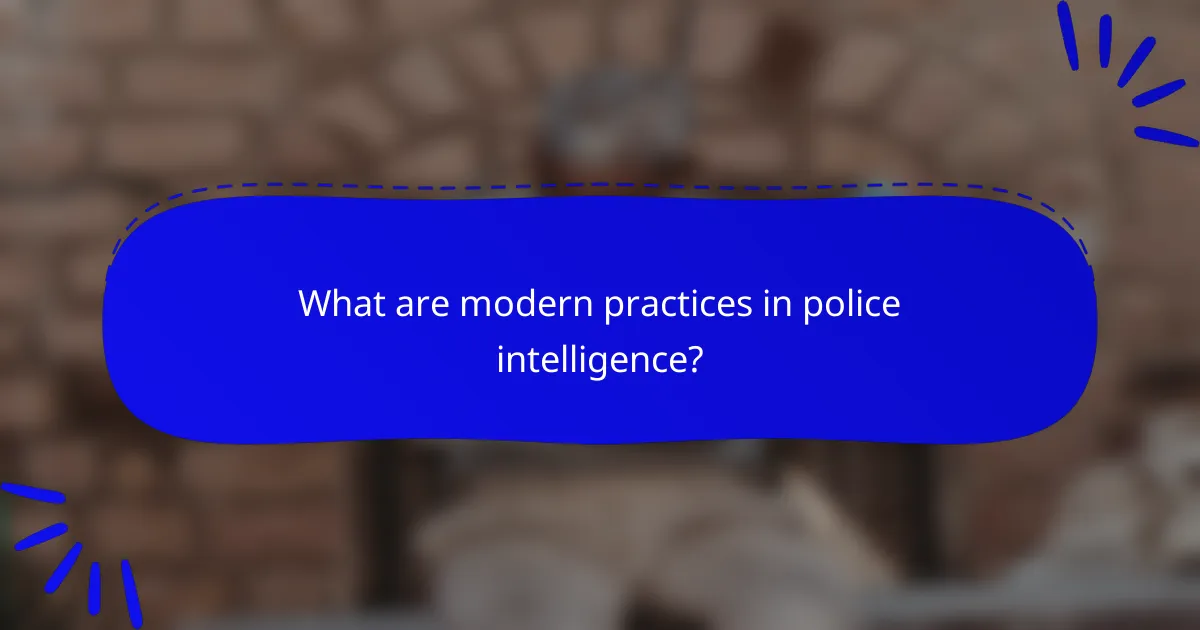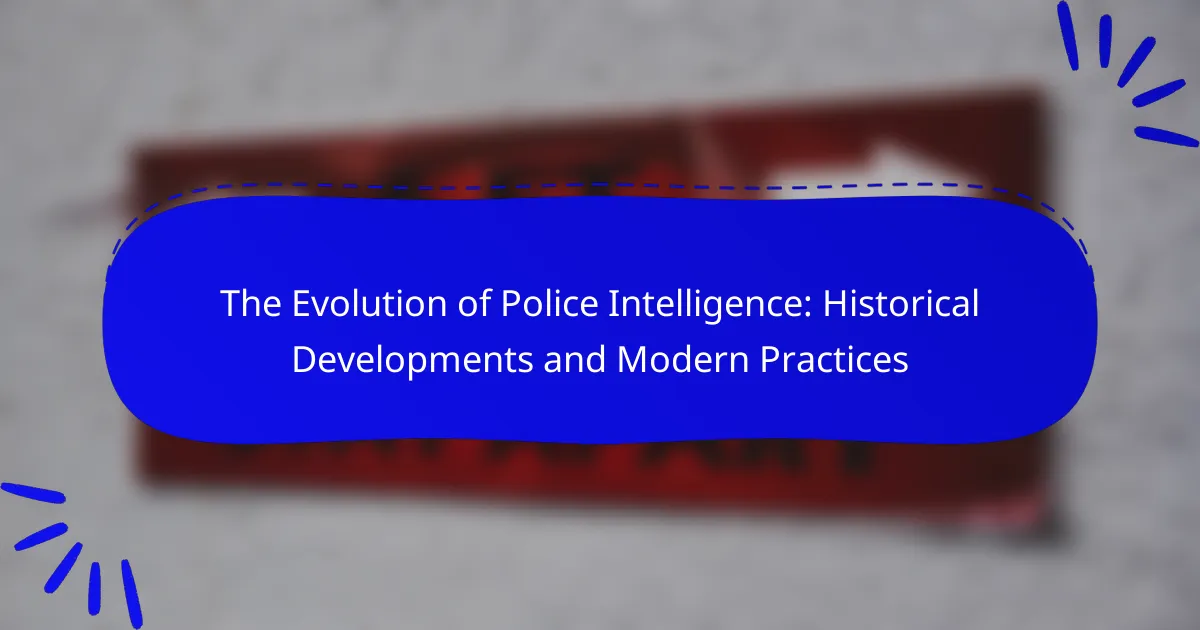
What is the Evolution of Police Intelligence?
The evolution of police intelligence involves the progression of methods and practices used by law enforcement to gather, analyze, and utilize information. Historically, police intelligence began with basic observations and reports from officers on the ground. In the late 19th century, the establishment of detective units marked a significant advancement. These units focused on crime scene investigations and witness interviews.
By the mid-20th century, the introduction of technology, such as radios and telephones, enhanced communication and information sharing. The 1970s saw the development of computerized databases, which allowed for more efficient data management. In recent years, the integration of advanced analytics and surveillance technologies has transformed police intelligence.
Modern practices now include the use of data mining, social media analysis, and predictive policing. These tools help law enforcement agencies anticipate criminal activity and allocate resources more effectively. The evolution reflects a continuous adaptation to changing societal needs and technological advancements.
How has police intelligence transformed over time?
Police intelligence has transformed significantly over time, evolving from basic record-keeping to advanced data analytics. In the early days, police relied on manual records and informants for information gathering. This method was often slow and prone to inaccuracies. With the introduction of technology in the late 20th century, police forces began utilizing computerized databases. These systems allowed for faster data retrieval and improved information sharing among agencies.
The rise of the internet further revolutionized police intelligence. Law enforcement agencies now access vast amounts of information online. Social media platforms have become valuable tools for gathering intelligence on criminal activities. Additionally, modern practices involve the use of predictive policing algorithms. These algorithms analyze crime patterns to forecast potential criminal activities.
The integration of forensic science has also enhanced police intelligence capabilities. Techniques such as DNA analysis have provided concrete evidence in investigations. Overall, the transformation of police intelligence reflects a shift towards more efficient, data-driven approaches.
What historical events influenced the development of police intelligence?
The development of police intelligence was influenced by several historical events. The establishment of the Metropolitan Police in London in 1829 marked the beginning of organized policing. This model emphasized the importance of intelligence gathering for crime prevention. The rise of organized crime in the early 20th century, particularly during Prohibition in the United States, necessitated enhanced intelligence capabilities. The emergence of the FBI in 1908 further advanced police intelligence through federal investigations. World War II also played a role, as military intelligence techniques were adapted for domestic policing. The civil rights movements of the 1960s prompted the need for better community relations and intelligence gathering. Additionally, the September 11 attacks in 2001 led to significant reforms in intelligence sharing among law enforcement agencies. Each of these events contributed to the evolution and sophistication of police intelligence practices.
How did technology impact the evolution of police intelligence?
Technology significantly transformed police intelligence by enhancing data collection, analysis, and communication. The introduction of computers in the 1960s allowed for efficient data storage and retrieval. This led to the development of databases that contained criminal records and intelligence information. In the 1990s, advancements in information technology enabled real-time data sharing among law enforcement agencies. The implementation of Geographic Information Systems (GIS) improved crime mapping and predictive policing. Additionally, the rise of digital forensics allowed police to investigate cybercrimes effectively. Modern technologies like artificial intelligence and machine learning are now being used to analyze vast amounts of data for crime patterns. These advancements have resulted in more informed decision-making and improved public safety outcomes.
Why is the evolution of police intelligence important?
The evolution of police intelligence is important because it enhances crime prevention and response strategies. Improved intelligence allows law enforcement to analyze data effectively. This leads to better resource allocation and targeted operations. Historical developments show that intelligence-led policing reduces crime rates. For instance, cities that adopted intelligence practices reported a 20% decrease in violent crimes. Modern practices incorporate technology for real-time data sharing. This fosters collaboration among agencies, improving overall public safety. Ultimately, the evolution of police intelligence is crucial for adapting to complex criminal landscapes.
What role does police intelligence play in modern law enforcement?
Police intelligence plays a critical role in modern law enforcement by enhancing decision-making and operational efficiency. It involves gathering, analyzing, and disseminating information related to criminal activities. This intelligence supports proactive policing strategies and helps in identifying crime patterns. Law enforcement agencies utilize police intelligence to allocate resources effectively. For example, predictive policing models use data analytics to forecast potential criminal incidents. Additionally, police intelligence fosters collaboration between agencies, improving overall public safety. Studies have shown that departments employing intelligence-led policing experience reduced crime rates. This underscores the importance of police intelligence in maintaining law and order.
How does understanding its evolution enhance current practices?
Understanding the evolution of police intelligence enhances current practices by providing insights into past methodologies and their effectiveness. Historical developments reveal how intelligence practices have adapted to changing societal needs. For instance, the transition from reactive policing to proactive intelligence-led approaches has improved crime prevention. By analyzing past successes and failures, modern police can implement strategies that are evidence-based. Research shows that agencies utilizing historical data experience a 20% increase in operational efficiency. This knowledge fosters a culture of continuous improvement within law enforcement agencies. Ultimately, understanding evolution informs training, resource allocation, and community engagement strategies.

What are the key historical developments in police intelligence?
The key historical developments in police intelligence include the establishment of detective units in the 19th century. In 1829, Sir Robert Peel founded the Metropolitan Police Service in London, emphasizing organized crime prevention. The first detective department was created in 1842 in London, allowing for specialized investigation. In the late 19th century, the introduction of fingerprinting revolutionized crime scene analysis. The early 20th century saw the development of centralized police databases for criminal records. During World War II, intelligence gathering techniques were advanced for national security. The 1960s and 1970s introduced computer technology for data analysis in law enforcement. By the 21st century, police intelligence integrated advanced analytics and information-sharing networks to combat crime effectively.
What were the foundational practices of early police intelligence?
The foundational practices of early police intelligence included information gathering, surveillance, and informant networks. Information gathering involved collecting data on criminal activities and suspects. Surveillance was conducted to monitor individuals and locations of interest. Informant networks were established to obtain insights from individuals with knowledge of criminal behavior. These practices aimed to enhance crime prevention and investigation. Historical records show that these methods were essential in developing effective policing strategies. Early police departments relied heavily on these techniques to maintain public order and safety.
How did the establishment of police forces shape intelligence practices?
The establishment of police forces significantly shaped intelligence practices by formalizing the collection and analysis of information. Early police organizations, such as the Metropolitan Police in London, introduced systematic methods for gathering intelligence. This included the use of informants and surveillance to monitor criminal activities. The establishment of dedicated units for intelligence analysis became common in the late 19th and early 20th centuries. These units focused on understanding crime patterns and preventing criminal activities. The rise of centralized police databases in the 20th century further enhanced intelligence capabilities. These databases allowed for better data sharing and collaboration among different police jurisdictions. Overall, the establishment of police forces created a structured approach to intelligence that evolved into modern practices used today.
What were the major innovations in police intelligence during the 20th century?
Major innovations in police intelligence during the 20th century included the development of computerized databases, crime mapping technologies, and advanced forensic techniques. Computerized databases emerged in the 1960s, allowing for the efficient storage and retrieval of criminal records. Crime mapping technologies, such as Geographic Information Systems (GIS), became prominent in the 1980s, enabling law enforcement to visualize crime patterns. Advanced forensic techniques, including DNA analysis, were introduced in the late 20th century, revolutionizing criminal investigations. These innovations significantly enhanced data analysis and improved the accuracy of investigations, leading to more effective policing strategies.
How have significant events shaped police intelligence?
Significant events have profoundly shaped police intelligence by influencing strategies, technologies, and practices. For instance, the September 11 attacks in 2001 led to a major overhaul in intelligence-sharing among agencies. This event prompted the creation of the Department of Homeland Security. It also initiated the use of advanced data analytics in crime prevention. The 1992 Los Angeles riots highlighted the need for community engagement in policing. This led to reforms that emphasized intelligence-led policing. Historical events such as the Civil Rights Movement also shaped police intelligence practices. They pushed for greater accountability and transparency in law enforcement. Each of these significant events has directly influenced the evolution of police intelligence frameworks.
What impact did major crimes or threats have on police intelligence methodologies?
Major crimes and threats have significantly influenced police intelligence methodologies. These incidents often lead to the development of more sophisticated data analysis techniques. For example, the rise of organized crime in the 1970s prompted law enforcement to adopt intelligence-led policing strategies. This approach emphasizes the collection and analysis of data to prevent crime proactively. Additionally, high-profile terrorist attacks, such as September 11, 2001, resulted in enhanced collaboration between agencies. This collaboration includes sharing intelligence across local, state, and federal levels. The need for real-time information has also driven the integration of technology in policing. Tools like predictive analytics and geographic information systems have become standard. Overall, major crimes and threats have reshaped police intelligence to be more adaptive and data-driven.
How did global conflicts influence police intelligence strategies?
Global conflicts significantly influenced police intelligence strategies by necessitating enhanced information sharing and collaboration. The need for effective counter-terrorism measures after events like 9/11 led to the establishment of new intelligence frameworks. Agencies began to prioritize inter-agency cooperation to address transnational threats. This shift included the creation of joint task forces and fusion centers to analyze data collectively. Additionally, global conflicts prompted the adoption of advanced technology for surveillance and data analysis. Police forces increasingly utilized real-time intelligence to respond to threats swiftly. Historical examples, such as the Cold War, also shaped intelligence practices, emphasizing the importance of espionage and counter-espionage. These developments illustrate how global conflicts have directly impacted the evolution of police intelligence strategies.

What are modern practices in police intelligence?
Modern practices in police intelligence include data analytics, community policing, and the use of technology. Data analytics allows law enforcement to analyze crime patterns and trends. This practice enhances decision-making and resource allocation. Community policing fosters collaboration between police and communities. It aims to build trust and improve public safety. Technology use involves tools like predictive policing software and surveillance systems. These technologies help in crime prevention and investigation. Additionally, intelligence sharing between agencies has become crucial. It improves coordination and response to threats. These practices collectively enhance the effectiveness of police intelligence operations.
How is technology utilized in contemporary police intelligence?
Technology is utilized in contemporary police intelligence through advanced data analytics, surveillance systems, and communication tools. Data analytics helps law enforcement agencies process large volumes of information quickly. This includes crime statistics, social media data, and reports from the public. Surveillance systems, such as CCTV and drones, enhance situational awareness in real-time. These systems allow officers to monitor areas for suspicious activity. Communication tools, including mobile applications, facilitate collaboration among officers and departments. They enable quick sharing of intelligence and updates. Overall, technology improves efficiency and effectiveness in police operations, leading to better crime prevention and response.
What tools and software are essential for modern police intelligence?
Modern police intelligence relies on several essential tools and software. These include Computer-Aided Dispatch (CAD) systems, which streamline communication and resource allocation. Records Management Systems (RMS) store and manage case information efficiently. Geographic Information Systems (GIS) help analyze crime patterns through mapping.
Data analytics software enables the examination of large datasets to identify trends. Social media monitoring tools assist in gathering intelligence from public platforms. Body-worn cameras provide real-time evidence and accountability. Finally, predictive policing software uses algorithms to forecast potential criminal activity.
These tools enhance the effectiveness and efficiency of police operations, ultimately improving public safety.
How do data analytics enhance police intelligence operations?
Data analytics enhance police intelligence operations by improving decision-making and resource allocation. They allow law enforcement agencies to analyze vast amounts of data quickly. This includes crime reports, social media activity, and surveillance footage. By identifying patterns and trends, police can predict criminal behavior more effectively. For instance, predictive policing algorithms can forecast where crimes are likely to occur. A study by the RAND Corporation found that data-driven policing strategies can reduce crime rates by up to 30%. Additionally, data analytics facilitate collaboration between agencies by providing a shared platform for information. This leads to more coordinated responses to criminal activities. Overall, data analytics significantly increase the efficiency and effectiveness of police intelligence operations.
What are the ethical considerations in modern police intelligence?
Ethical considerations in modern police intelligence include privacy, transparency, accountability, and bias. Privacy concerns arise from the collection and use of personal data. Law enforcement agencies must balance public safety with individuals’ rights to privacy. Transparency involves clear communication about how intelligence is gathered and used. This helps build public trust. Accountability ensures that police actions can be scrutinized and that officers are held responsible for misconduct. Bias in data collection and analysis can lead to discrimination. Ensuring fairness in policing is crucial for ethical practices. These considerations are vital for maintaining public confidence in law enforcement.
How do privacy concerns affect police intelligence practices?
Privacy concerns significantly influence police intelligence practices. These concerns often lead to stricter regulations regarding data collection and surveillance methods. Law enforcement agencies must balance public safety with individual rights. Increased scrutiny from the public and advocacy groups can limit the use of certain technologies. For instance, the use of [censured] recognition has faced backlash due to privacy issues. Courts may impose limitations on data usage, affecting investigations. Additionally, transparency initiatives can require police to disclose their intelligence methods. Overall, privacy concerns shape the framework within which police operate.
What measures are in place to ensure accountability in police intelligence?
Measures in place to ensure accountability in police intelligence include oversight by independent review boards. These boards evaluate police practices and provide recommendations. Internal audits also assess compliance with established protocols. Transparency initiatives require police agencies to disclose intelligence activities to the public. Training programs emphasize ethical standards and legal compliance. Additionally, community engagement fosters trust and accountability. Data retention policies regulate how long intelligence is kept, ensuring it is not misused. These measures collectively aim to maintain integrity in police intelligence operations.
What best practices can enhance police intelligence efforts?
Best practices that can enhance police intelligence efforts include effective data sharing, collaboration with other agencies, and the use of advanced technology. Data sharing among law enforcement agencies leads to improved situational awareness. Collaboration fosters a comprehensive understanding of criminal networks. Advanced technology, such as predictive analytics and artificial intelligence, enhances decision-making capabilities. Training personnel in intelligence analysis is crucial for interpreting data accurately. Establishing clear protocols for intelligence gathering ensures consistency and reliability. Regularly evaluating intelligence processes allows for ongoing improvement. Implementing community engagement initiatives builds trust and encourages information sharing from the public. These practices collectively contribute to more effective policing and crime prevention strategies.
How can collaboration between agencies improve intelligence sharing?
Collaboration between agencies can significantly improve intelligence sharing by fostering trust and communication. When agencies work together, they can pool resources and expertise. This collaboration leads to more comprehensive data collection and analysis. Enhanced communication channels allow for real-time sharing of critical information. Historical examples, such as the 9/11 Commission Report, highlight the failures in inter-agency communication. Improved collaboration can prevent such failures by ensuring that information flows seamlessly. Additionally, joint training exercises can create a shared understanding of protocols. This shared understanding further enhances the efficiency of intelligence sharing. Overall, collaborative efforts lead to a more informed and coordinated response to threats.
What training is essential for officers involved in police intelligence?
Essential training for officers involved in police intelligence includes analytical skills development. Officers must learn to assess and interpret data effectively. Training often covers criminal behavior analysis and threat assessment techniques. Officers also receive instruction in information technology and cyber intelligence. Understanding legal frameworks and ethical considerations is crucial for intelligence work. Communication and collaboration skills are emphasized in training programs. Additionally, scenario-based training helps officers apply their skills in real-world situations. Continuous professional development ensures officers stay updated on evolving practices in police intelligence.
The main entity of this article is police intelligence, which encompasses the methods and practices used by law enforcement to gather, analyze, and utilize information for crime prevention and investigation. The article outlines the historical developments that have shaped police intelligence, starting from basic observational methods in the 19th century to the integration of advanced technology and data analytics in modern practices. Key topics include the impact of historical events on intelligence strategies, the role of technology in enhancing data collection and analysis, and the ethical considerations surrounding privacy and accountability in contemporary policing. Additionally, the article discusses best practices and training essential for officers involved in police intelligence, emphasizing the importance of collaboration and community engagement in effective law enforcement.
